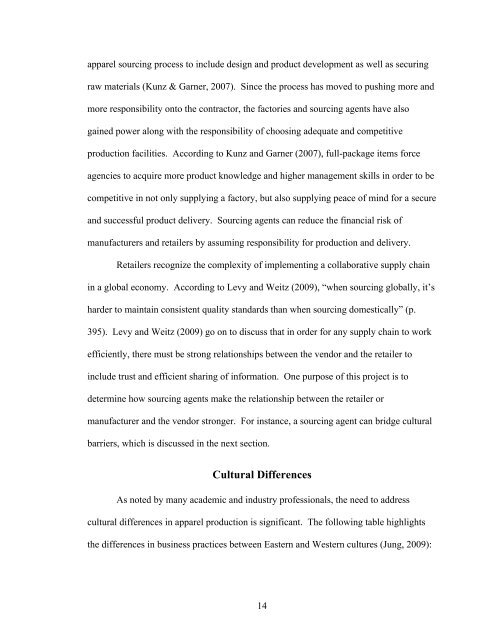the role of sourcing agents in global apparel supply chains
the role of sourcing agents in global apparel supply chains
the role of sourcing agents in global apparel supply chains
You also want an ePaper? Increase the reach of your titles
YUMPU automatically turns print PDFs into web optimized ePapers that Google loves.
<strong>apparel</strong> <strong>sourc<strong>in</strong>g</strong> process to <strong>in</strong>clude design and product development as well as secur<strong>in</strong>g<br />
raw materials (Kunz & Garner, 2007). S<strong>in</strong>ce <strong>the</strong> process has moved to push<strong>in</strong>g more and<br />
more responsibility onto <strong>the</strong> contractor, <strong>the</strong> factories and <strong>sourc<strong>in</strong>g</strong> <strong>agents</strong> have also<br />
ga<strong>in</strong>ed power along with <strong>the</strong> responsibility <strong>of</strong> choos<strong>in</strong>g adequate and competitive<br />
production facilities. Accord<strong>in</strong>g to Kunz and Garner (2007), full-package items force<br />
agencies to acquire more product knowledge and higher management skills <strong>in</strong> order to be<br />
competitive <strong>in</strong> not only <strong>supply</strong><strong>in</strong>g a factory, but also <strong>supply</strong><strong>in</strong>g peace <strong>of</strong> m<strong>in</strong>d for a secure<br />
and successful product delivery. Sourc<strong>in</strong>g <strong>agents</strong> can reduce <strong>the</strong> f<strong>in</strong>ancial risk <strong>of</strong><br />
manufacturers and retailers by assum<strong>in</strong>g responsibility for production and delivery.<br />
Retailers recognize <strong>the</strong> complexity <strong>of</strong> implement<strong>in</strong>g a collaborative <strong>supply</strong> cha<strong>in</strong><br />
<strong>in</strong> a <strong>global</strong> economy. Accord<strong>in</strong>g to Levy and Weitz (2009), “when <strong>sourc<strong>in</strong>g</strong> <strong>global</strong>ly, it’s<br />
harder to ma<strong>in</strong>ta<strong>in</strong> consistent quality standards than when <strong>sourc<strong>in</strong>g</strong> domestically” (p.<br />
395). Levy and Weitz (2009) go on to discuss that <strong>in</strong> order for any <strong>supply</strong> cha<strong>in</strong> to work<br />
efficiently, <strong>the</strong>re must be strong relationships between <strong>the</strong> vendor and <strong>the</strong> retailer to<br />
<strong>in</strong>clude trust and efficient shar<strong>in</strong>g <strong>of</strong> <strong>in</strong>formation. One purpose <strong>of</strong> this project is to<br />
determ<strong>in</strong>e how <strong>sourc<strong>in</strong>g</strong> <strong>agents</strong> make <strong>the</strong> relationship between <strong>the</strong> retailer or<br />
manufacturer and <strong>the</strong> vendor stronger. For <strong>in</strong>stance, a <strong>sourc<strong>in</strong>g</strong> agent can bridge cultural<br />
barriers, which is discussed <strong>in</strong> <strong>the</strong> next section.<br />
Cultural Differences<br />
As noted by many academic and <strong>in</strong>dustry pr<strong>of</strong>essionals, <strong>the</strong> need to address<br />
cultural differences <strong>in</strong> <strong>apparel</strong> production is significant. The follow<strong>in</strong>g table highlights<br />
<strong>the</strong> differences <strong>in</strong> bus<strong>in</strong>ess practices between Eastern and Western cultures (Jung, 2009):<br />
14
















